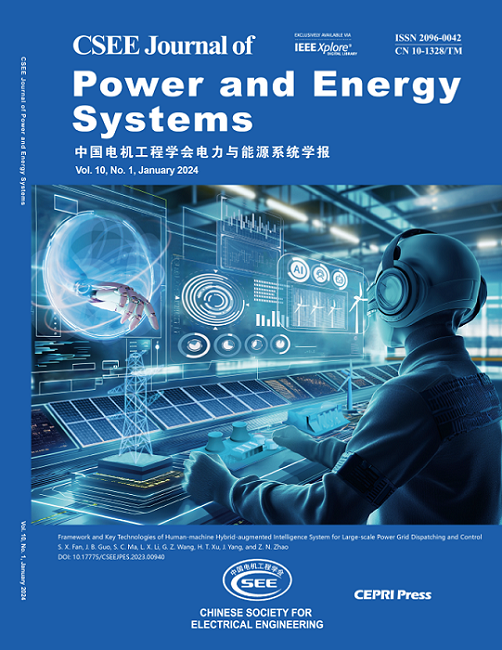Joint Chance-Constrained Economic Dispatch Involving Joint Optimization of Frequency-Related Inverter Control and Regulation Reserve Allocation
IF 5.9
2区 工程技术
Q2 ENERGY & FUELS
引用次数: 0
Abstract
The issues of uncertainty and frequency security become significantly serious in power systems with the high penetration of volatile inverter-based renewables (IBRs), which makes it necessary to consider the uncertainty and frequency-related constraints in the economic dispatch (ED) programs. However, existing ED studies rarely proactively optimize the control parameters of inverter-based resources related to fast regulation (e.g., virtual inertia and droop coefficients) in co-operation with other dispatchable resources to improve the system frequency security and dispatch reliability. This paper proposes a joint chance-constrained economic dispatch model that jointly optimizes the frequency-related inverter control, the system up/down reserves, and base-point power for the minimal total operational cost. In the proposed model, multiple dispatchable resources, including thermal units, dispatchable IBRs, and energy storage, are considered, and the (virtual) inertias, the regulation reserve allocations, and base-point power are coordinated. To ensure the system reliability, the joint chance-constraint formulation is also adopted. Additionally, since the traditional sample average approximation (SAA) method imposes a huge computational burden, a novel mix-SAA (MSAA) method is proposed to transform the original intractable model into a linear model that can be efficiently solved via commercial solvers. The case studies validate the satisfactory efficacy of the proposed ED model and demonstrate that the MSAA can save nearly 90% calculation time compared with the traditional SAA.频率相关逆变器控制与调节储备分配联合优化的联合机会约束经济调度
随着可再生能源(IBRs)的高渗透率,电力系统的不确定性和频率安全问题变得越来越严重,这使得在经济调度(ED)方案中考虑不确定性和频率相关约束成为必要。然而,现有的ED研究很少主动优化与快速调节相关的逆变器资源的控制参数(如虚拟惯性和下垂系数),并与其他可调度资源合作,以提高系统的频率安全性和调度可靠性。本文提出了一种联合机会约束的经济调度模型,该模型以最小的总运行成本为目标,对频率相关逆变器控制、系统上下备用和基点功率进行联合优化。在该模型中,考虑了多个可调度资源,包括热机组、可调度ibr和储能,并协调了(虚拟)惯性、调节储备分配和基点功率。为了保证系统的可靠性,还采用了联合机会约束公式。此外,针对传统的样本平均近似(SAA)方法计算量大的问题,提出了一种新的混合样本平均近似(MSAA)方法,将原有的难解模型转化为可通过商业求解器高效求解的线性模型。算例验证了该模型的有效性,结果表明,该模型与传统模型相比可节省近90%的计算时间。
本文章由计算机程序翻译,如有差异,请以英文原文为准。
求助全文
约1分钟内获得全文
求助全文
来源期刊

CSEE Journal of Power and Energy Systems
Energy-Energy (all)
CiteScore
11.80
自引率
12.70%
发文量
389
审稿时长
26 weeks
期刊介绍:
The CSEE Journal of Power and Energy Systems (JPES) is an international bimonthly journal published by the Chinese Society for Electrical Engineering (CSEE) in collaboration with CEPRI (China Electric Power Research Institute) and IEEE (The Institute of Electrical and Electronics Engineers) Inc. Indexed by SCI, Scopus, INSPEC, CSAD (Chinese Science Abstracts Database), DOAJ, and ProQuest, it serves as a platform for reporting cutting-edge theories, methods, technologies, and applications shaping the development of power systems in energy transition. The journal offers authors an international platform to enhance the reach and impact of their contributions.
 求助内容:
求助内容: 应助结果提醒方式:
应助结果提醒方式:


